EUR/USD
Sharp recovery following positive news.
EUR/USD extended sharply higher, as six central banks, reduced their USD funding costs to ease the debt crisis. The impact was very positive for investors around the world and has encouraged traditional “risk appetite” markets, such as EUR/USD, AUD/USD and S&P500 to turn back higher.
Expect the recovery to be limited into 1.3610, then 1.3730 and perhaps even 1.3850-90. Probability still favours a bearish reversal at these levels.
Meantime, support can be found at 1.3380 and 1.3146. A sustained close beneath 1.3146 (Oct swing low) will re-establish the larger downtrend from April and target 1.3000 (psychological level), then 1.2870 (2011 major low).
Inversely, the USD Index is maintaining its recovery higher and still targets its recent 9-month highs near 80, (a move worth almost 10%).
Speculative (net long) liquidity flows have unwound from recent spike highs (3 standard deviations from the yearly average). This will likely remain strong and help resume the USD’s major bull-run from its historic oversold extremes (momentum, sentiment and liquidity).

GBP/USD
Meets resistance close to a 50% retrace, in the daily timeframe.
GBP/USD has met initial resistance close to the 50% retrace of the 1.6167 – 1.5423 fall. A further push under 1.5577 in the hourly timeframe will continue to weaken the near-term structure, warning of an increased likelihood of continuation back towards 1.5423. Alternatively, a push back over 1.5726 will warn of a fresh leg higher in the recovery from 1.5423.
A return to stresses in the Euro-Zone, driving sovereign yields higher, is anticipated and thus Sterling has the capacity to be deemed as a safe haven.
With the above in mind it may be advantageous to sell into a break under the recent 1.5577 low, for a near-term return to 1.5423.
Alternatively buying at lower levels for a return to range bound trading is a medium-term option.
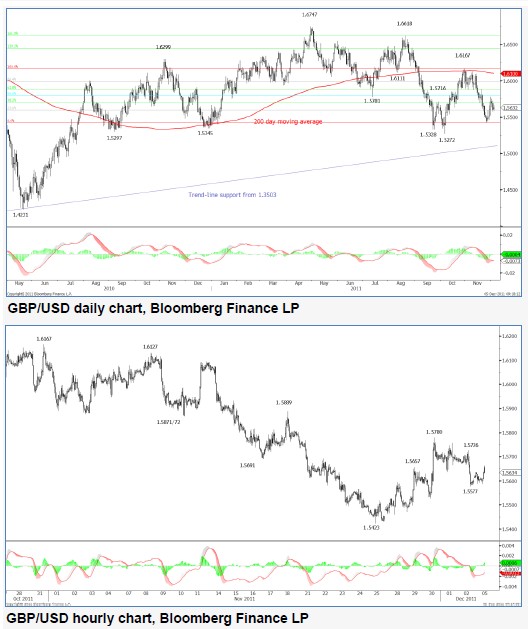
USD/JPY
Minor rebound capped at 78.24 (DeMark™ Level).
USD/JPY’s minor rebound is still being capped at 78.24 (DeMark™ Level). Moreover, downside risks remain, with the growing probability of a third price retracement back to pre-intervention levels (PIR III) and potentially even a new post world war record low beneath 75.35 (PINL).
Sentiment in the option markets continues to suggest that USD/JPY buying pressure remains overcrowded as everyone continues to try and be the first to call the market bottom.
This may inspire a temporary, but dramatic, price spike through psychological levels at 75.00 and perhaps even sub-74.00. Such a move would help flush out a number of downside barriers and stop-loss orders, which would create healthy price vacuum for a potential major reversal.
The medium/long-term view remains bullish, as USD/JPY verges toward a major long-term 40-year cycle upside reversal. Expect key cycle inflection points to trigger into November-December this year, offering a sustained move above our upside trigger level at 80.00/60, then 82.00 and 83.30.
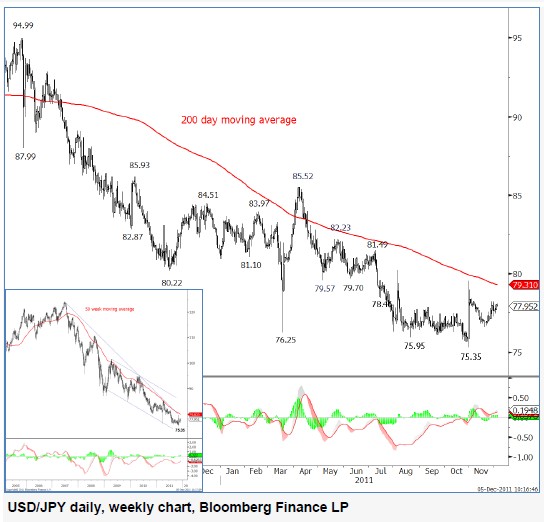
USD/CHF
Back over 0.9252 will suggest end of corrective phase.
USD/CHF exhibits an hourly structure in the fall from 0.9331 – 0.9066 that suggests the correction from the former may now be complete. However, a push back over 0.9252 is required to confirm this, negating a re-test of the 0.9000 level.
We are wary of selling at current levels as downside pressure from rising Euro-Zone yields has eased somewhat following the reduction in the interest rate offered on USD based swap lines. Spanish and Italian government bonds remain elevated, currently trading at 5.337% and 6.264% versus 6.478% and 7.355%, before the six party central bank agreement.
Looking at the German sovereign yield curve in particular we note that yields are lower across all maturities when compared with a week ago (with the exception of 6 months). Assuming German yields are not pressured to the upside, this should also act to ease downside pressure in USD/CHF.
Movement in USD/CHF is likely to be affected by EUR/CHF should the latter rate get closer to the 1.2130 region, which marks the lower end of the recent trading range.

USD/CAD
Sharp Setbacks hold steady.
USD/CAD’s sharp setbacks are holding steady today, following the recent short-term DeMark™ exhaustion sell signal.
A directional confirmation above 1.0658 is still needed to unlock the recovery into 1.0850 plus. This would extend the upside breakout from the rate’s ending triangle pattern, which was part of a major Elliott Wave cycle.
Only a sustained close beneath 1.0120 and parity unlocks bearish setbacks into the long-term 200-day MA at 0.9852 and 0.9726 (31st Aug low).
EUR/CAD remains beneath its 200-day MA, still within a large multi-month trading range. The strong multi-month distribution pattern is likely to\ breakdown further into support levels at 1.3570 and 1.3380.
CHF/CAD has also broken back beneath its 200-day MA at 1.1375, while breaching a multi-week trading range. This follows the dramatic price slide lower (which was triggered by the SNB intervention). The cross-rate has retraced more than half of its 2011 gains.
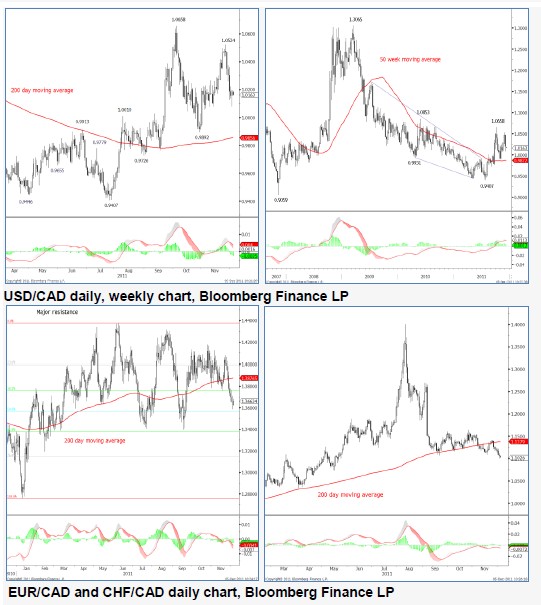
AUD/USD
Extended recovery beneath 200-day MA.
AUD/USD has extended its recovery into key resistance at 1.0340 (61.8% Fib-Oct 28th decline) and 200-day MA which is currently holding at 1.0412.
The bears must sustain below 1.0000 to further compound downside pressure on the rate’s multi-year uptrend and push back towards 0.9611.
Elsewhere, the Aussie dollar remains strong against the New Zealand dollar. However, near-term price activity is mean reverting back into the 200- day MA. Expect a sharp setback to ensue over the multi-day horizon.
The Aussie dollar has triggered a mild recovery against the Japanese yen and is now trading back above the neck-line of its two-year distribution pattern. Watch for further downside scope into support at 72.00 which would signal further unwinding of risk appetite.
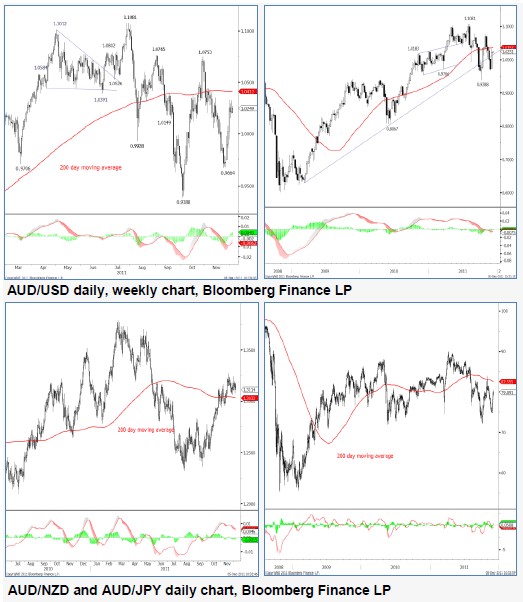
GBP/JPY
Rising wedge warns of exhaustion.
GBP/JPY appears to be losing upside momentum, forming a rising wedge in the hourly timeframe. This suggests that the corrective phase from 119.38 may be reaching exhaustion.
The bias now returns to negative again, with scope for a degree of support to manifest, should a fall to the 120.00 region materialise.
We now seek a break over the resistance of the rising wedge, to complete this formation. In particular we seek a slow-down in momentum ahead of a potential period of weakness.
A failure to hold over 119.38 will warn of a return to 116.84. Over a longer period of time a substantial recovery higher is favoured, initially towards 163.09.

EUR/JPY
In the final phases of a short-term correction higher.
EUR/JPY appears to be in the final phases of a correction higher from the recent low at 102.49.
We also view the fall that has taken place since 111.60 as being corrective in nature, suggesting potential for a return to this same level.
However, the EUR component of this pair is highly affected by the movement in EUR/USD. A break under 1.3146 in EUR/USD will end the rising phase seen since 2010. This would likely be associated with a fall back down to 100.76 and potentially lower.
Given the above clash between the structure and events in the Euro-Zone, we prefer to wait on the side lines.
A sustained hold over the 200 day moving average will turn the mediumterm outlook more bullish.
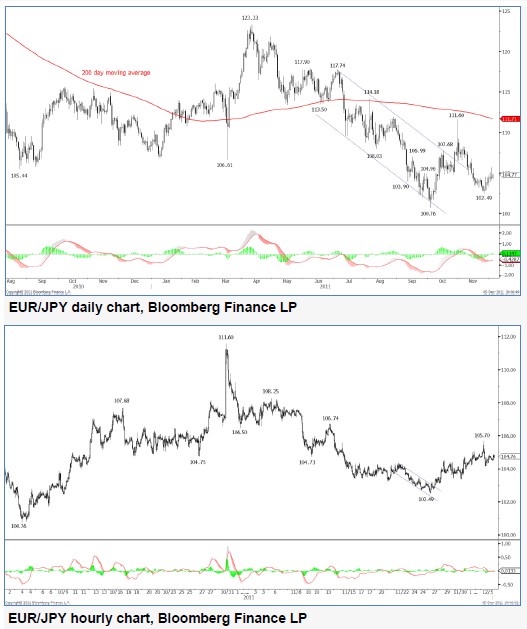
EUR/GBP
Failed downside break warns of a larger corrective phase higher.
EUR/GBP failed to gain momentum again, this time in the hourly timeframe, after breaking under 0.8528. This now warns of a larger rise higher, back towards the 0.8700 region. As has already been seen, following the recent push under 0.8530/31, this failure to garner momentum is a hallmark of this currency pair in recent trade. Thus the strategy remains to sell, but at higher levels.
Given the precarious situation in the Euro-Zone, it is anticipated that if yield curve deterioration continues then Sterling could be viewed as a safe haven. Italian and Spanish government bond yields have eased back somewhat after the coordinated cut in USD based swap lines amongst selected central banks. However, a lasting solution still appears a long way off with the recent intervention simply easing a dire situation.
Our bias remains mildly bearish with trade continuing under both the 200 day and 50 week moving averages. We keep an eye on the 1.3146 level in EUR/USD. A push under this level will mark a clear breakdown of confidence in the EUR, which would then likely have a knock on effect on all EUR crosses.

EUR/CHF
A re-test of the 1.2123/31 region favoured.
EUR/CHF continues to trade in a tight range failing to meet the 1.2500 level. Following the recent six bank dollar swap rate coordination, yields in many
Euro-Zone sovereign bond markets have fallen back, easing the downside pressure in EUR/CHF.
Our strategy is to trade opportunistically from a momentum perspective, awaiting a return to the 1.2000 region. Should a re-test of the 1.2000 region take place with a fall under 1.1973 also following, this would warn of the end of the recovery seen since 1.0075, increasing the probability of a return to this level.
Near-term, a break back under 1.2226 will warn of a failure to re-test the 1.2500 region, suggesting an earlier return to 1.2123/31. In any case, a retest of the base of the recent trading range is anticipated over coming sessions.
The failure of this pair to break over the 50 week moving average over recent weeks is also an initial warning that the prior downtrend may not be over. The large cluster of stops that is likely to be placed around the 1.2000 level is also anticipated to aid any short positioning, questioning the ability of the SNB to hold back the possible flow of funds into Swiss Francs.
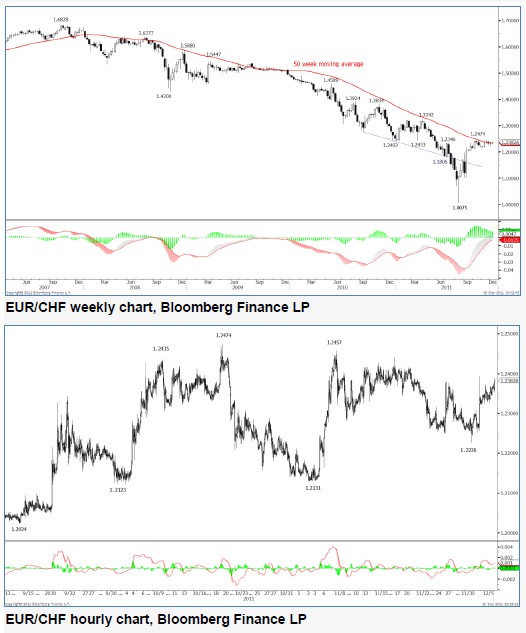
Sharp recovery following positive news.
EUR/USD extended sharply higher, as six central banks, reduced their USD funding costs to ease the debt crisis. The impact was very positive for investors around the world and has encouraged traditional “risk appetite” markets, such as EUR/USD, AUD/USD and S&P500 to turn back higher.
Expect the recovery to be limited into 1.3610, then 1.3730 and perhaps even 1.3850-90. Probability still favours a bearish reversal at these levels.
Meantime, support can be found at 1.3380 and 1.3146. A sustained close beneath 1.3146 (Oct swing low) will re-establish the larger downtrend from April and target 1.3000 (psychological level), then 1.2870 (2011 major low).
Inversely, the USD Index is maintaining its recovery higher and still targets its recent 9-month highs near 80, (a move worth almost 10%).
Speculative (net long) liquidity flows have unwound from recent spike highs (3 standard deviations from the yearly average). This will likely remain strong and help resume the USD’s major bull-run from its historic oversold extremes (momentum, sentiment and liquidity).

GBP/USD
Meets resistance close to a 50% retrace, in the daily timeframe.
GBP/USD has met initial resistance close to the 50% retrace of the 1.6167 – 1.5423 fall. A further push under 1.5577 in the hourly timeframe will continue to weaken the near-term structure, warning of an increased likelihood of continuation back towards 1.5423. Alternatively, a push back over 1.5726 will warn of a fresh leg higher in the recovery from 1.5423.
A return to stresses in the Euro-Zone, driving sovereign yields higher, is anticipated and thus Sterling has the capacity to be deemed as a safe haven.
With the above in mind it may be advantageous to sell into a break under the recent 1.5577 low, for a near-term return to 1.5423.
Alternatively buying at lower levels for a return to range bound trading is a medium-term option.

USD/JPY
Minor rebound capped at 78.24 (DeMark™ Level).
USD/JPY’s minor rebound is still being capped at 78.24 (DeMark™ Level). Moreover, downside risks remain, with the growing probability of a third price retracement back to pre-intervention levels (PIR III) and potentially even a new post world war record low beneath 75.35 (PINL).
Sentiment in the option markets continues to suggest that USD/JPY buying pressure remains overcrowded as everyone continues to try and be the first to call the market bottom.
This may inspire a temporary, but dramatic, price spike through psychological levels at 75.00 and perhaps even sub-74.00. Such a move would help flush out a number of downside barriers and stop-loss orders, which would create healthy price vacuum for a potential major reversal.
The medium/long-term view remains bullish, as USD/JPY verges toward a major long-term 40-year cycle upside reversal. Expect key cycle inflection points to trigger into November-December this year, offering a sustained move above our upside trigger level at 80.00/60, then 82.00 and 83.30.

USD/CHF
Back over 0.9252 will suggest end of corrective phase.
USD/CHF exhibits an hourly structure in the fall from 0.9331 – 0.9066 that suggests the correction from the former may now be complete. However, a push back over 0.9252 is required to confirm this, negating a re-test of the 0.9000 level.
We are wary of selling at current levels as downside pressure from rising Euro-Zone yields has eased somewhat following the reduction in the interest rate offered on USD based swap lines. Spanish and Italian government bonds remain elevated, currently trading at 5.337% and 6.264% versus 6.478% and 7.355%, before the six party central bank agreement.
Looking at the German sovereign yield curve in particular we note that yields are lower across all maturities when compared with a week ago (with the exception of 6 months). Assuming German yields are not pressured to the upside, this should also act to ease downside pressure in USD/CHF.
Movement in USD/CHF is likely to be affected by EUR/CHF should the latter rate get closer to the 1.2130 region, which marks the lower end of the recent trading range.

USD/CAD
Sharp Setbacks hold steady.
USD/CAD’s sharp setbacks are holding steady today, following the recent short-term DeMark™ exhaustion sell signal.
A directional confirmation above 1.0658 is still needed to unlock the recovery into 1.0850 plus. This would extend the upside breakout from the rate’s ending triangle pattern, which was part of a major Elliott Wave cycle.
Only a sustained close beneath 1.0120 and parity unlocks bearish setbacks into the long-term 200-day MA at 0.9852 and 0.9726 (31st Aug low).
EUR/CAD remains beneath its 200-day MA, still within a large multi-month trading range. The strong multi-month distribution pattern is likely to\ breakdown further into support levels at 1.3570 and 1.3380.
CHF/CAD has also broken back beneath its 200-day MA at 1.1375, while breaching a multi-week trading range. This follows the dramatic price slide lower (which was triggered by the SNB intervention). The cross-rate has retraced more than half of its 2011 gains.

AUD/USD
Extended recovery beneath 200-day MA.
AUD/USD has extended its recovery into key resistance at 1.0340 (61.8% Fib-Oct 28th decline) and 200-day MA which is currently holding at 1.0412.
The bears must sustain below 1.0000 to further compound downside pressure on the rate’s multi-year uptrend and push back towards 0.9611.
Elsewhere, the Aussie dollar remains strong against the New Zealand dollar. However, near-term price activity is mean reverting back into the 200- day MA. Expect a sharp setback to ensue over the multi-day horizon.
The Aussie dollar has triggered a mild recovery against the Japanese yen and is now trading back above the neck-line of its two-year distribution pattern. Watch for further downside scope into support at 72.00 which would signal further unwinding of risk appetite.

GBP/JPY
Rising wedge warns of exhaustion.
GBP/JPY appears to be losing upside momentum, forming a rising wedge in the hourly timeframe. This suggests that the corrective phase from 119.38 may be reaching exhaustion.
The bias now returns to negative again, with scope for a degree of support to manifest, should a fall to the 120.00 region materialise.
We now seek a break over the resistance of the rising wedge, to complete this formation. In particular we seek a slow-down in momentum ahead of a potential period of weakness.
A failure to hold over 119.38 will warn of a return to 116.84. Over a longer period of time a substantial recovery higher is favoured, initially towards 163.09.

EUR/JPY
In the final phases of a short-term correction higher.
EUR/JPY appears to be in the final phases of a correction higher from the recent low at 102.49.
We also view the fall that has taken place since 111.60 as being corrective in nature, suggesting potential for a return to this same level.
However, the EUR component of this pair is highly affected by the movement in EUR/USD. A break under 1.3146 in EUR/USD will end the rising phase seen since 2010. This would likely be associated with a fall back down to 100.76 and potentially lower.
Given the above clash between the structure and events in the Euro-Zone, we prefer to wait on the side lines.
A sustained hold over the 200 day moving average will turn the mediumterm outlook more bullish.

EUR/GBP
Failed downside break warns of a larger corrective phase higher.
EUR/GBP failed to gain momentum again, this time in the hourly timeframe, after breaking under 0.8528. This now warns of a larger rise higher, back towards the 0.8700 region. As has already been seen, following the recent push under 0.8530/31, this failure to garner momentum is a hallmark of this currency pair in recent trade. Thus the strategy remains to sell, but at higher levels.
Given the precarious situation in the Euro-Zone, it is anticipated that if yield curve deterioration continues then Sterling could be viewed as a safe haven. Italian and Spanish government bond yields have eased back somewhat after the coordinated cut in USD based swap lines amongst selected central banks. However, a lasting solution still appears a long way off with the recent intervention simply easing a dire situation.
Our bias remains mildly bearish with trade continuing under both the 200 day and 50 week moving averages. We keep an eye on the 1.3146 level in EUR/USD. A push under this level will mark a clear breakdown of confidence in the EUR, which would then likely have a knock on effect on all EUR crosses.

EUR/CHF
A re-test of the 1.2123/31 region favoured.
EUR/CHF continues to trade in a tight range failing to meet the 1.2500 level. Following the recent six bank dollar swap rate coordination, yields in many
Euro-Zone sovereign bond markets have fallen back, easing the downside pressure in EUR/CHF.
Our strategy is to trade opportunistically from a momentum perspective, awaiting a return to the 1.2000 region. Should a re-test of the 1.2000 region take place with a fall under 1.1973 also following, this would warn of the end of the recovery seen since 1.0075, increasing the probability of a return to this level.
Near-term, a break back under 1.2226 will warn of a failure to re-test the 1.2500 region, suggesting an earlier return to 1.2123/31. In any case, a retest of the base of the recent trading range is anticipated over coming sessions.
The failure of this pair to break over the 50 week moving average over recent weeks is also an initial warning that the prior downtrend may not be over. The large cluster of stops that is likely to be placed around the 1.2000 level is also anticipated to aid any short positioning, questioning the ability of the SNB to hold back the possible flow of funds into Swiss Francs.

